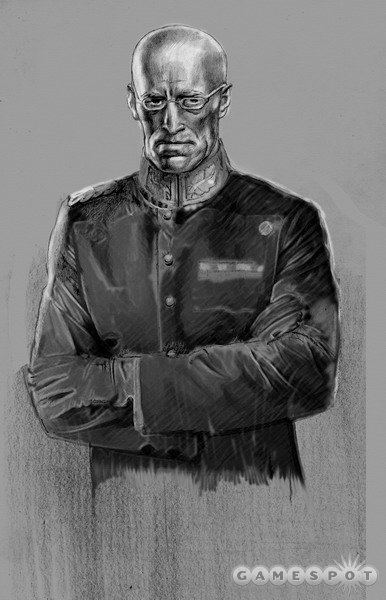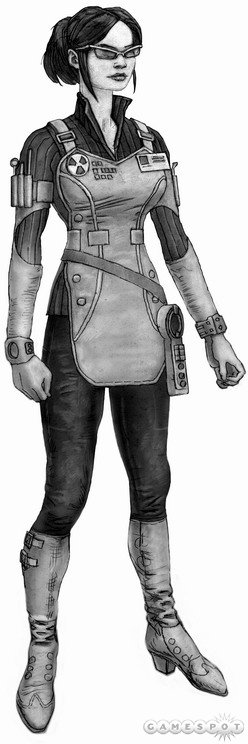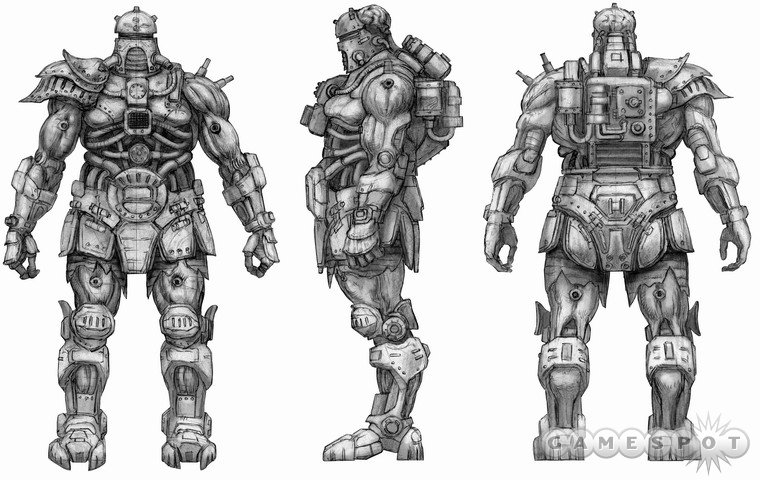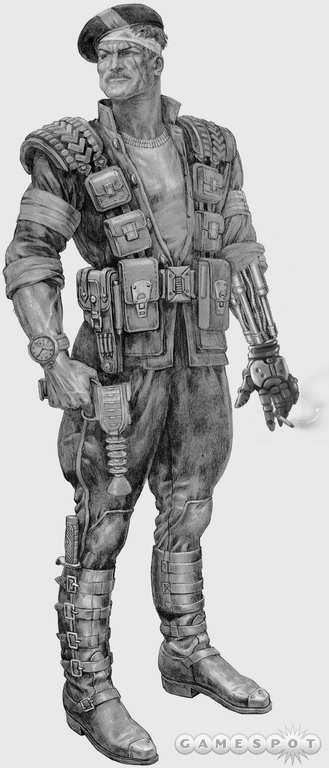TimeShift Designer Diary #2 - The Formula for Time Travel
How do you make an engaging and captivating shooter? Matthew Karch, CEO of Saber Interactive, gives us his thoughts as they relate to the upcoming TimeShift.
You'll discover that time is definitely on your side next year when TimeShift ships. This innovative first-person shooter will feature a sophisticated time-traveling system that will let you pause, slow down, and rewind time, even while in the midst of fierce gunfights. You'll also use your time powers to solve some tricky puzzles, as well. Put it together with great-looking graphics (in both the PC and Xbox 360 versions), and TimeShift is one of the interesting shooters of 2006. In the second installment of our designer diaries, we learn just why developer Saber Interactive thinks it has the magic formula for time-travel gameplay.

The Formula for Time Travel
Matthew KarchCEO, Saber Interactive
What makes a game good? What makes you pick up a game and want to play it? More importantly, what makes you not want to put it down? Is it the mere fact that the game is a sequel and that the previous game was pretty good? Is it the participation of some well-known actor as the voice of the game's hero? Or how about the affiliation of some other "celebrity"? If you are an avid gamer like I am then you are looking for something more, for that elusive something that is considered the holy grail of good game design: immersion.
How do you immerse a player in a gameworld? How do you (to use another industry watchword) suspend a player's disbelief? How do you keep a player involved and interested in a game from start to finish? While any number of factors can immediately kill immersion (bad visuals, amateur voice acting, and a story written by a programmer) it is much tougher to actually pinpoint what results in immersion. While there is no magic formula that achieves this objective, there are certain design elements that are absolutely essential to at least have a chance of accomplishing this ultimate design goal.
In this second segment of the TimeShift diaries I am going to talk with you a little bit about how we designed and structured the single-player campaign to keep you immersed in the TimeShift world from the game's first shot until its stunning climax.
One of our design goals from day one of the project was to provide you with as much variety in terms of visuals as possible in the time frame of our development. Too many games place you in one type of environment and keep you there for the duration of the game. No matter how great the lighting is and no matter how detailed the environments may be, it just gets boring to spend all of your gameplay hours in a space station or an office building.

In TimeShift, we send you on a journey to a completely foreign (yet familiar) world. How realistic would it be if you spent all of your time in one place? How limited would the gameplay be? In the course of designing the single-player campaign we made a conscious effort to create a game that would take you to as many places as possible. While this was extremely art-intensive, the payoff is a game that has very little repetition of environments. In fact, the design philosophy was that we would reuse game environments only where we had to for logic and storytelling reasons. Thus, in TimeShift you will visit the streets of Washington DC in an altered present and an entirely different version of Washington DC in the year 1911. You will ride through snow-covered alpine passes and temperate forests in the springtime. You will man large cannons as you defend a zeppelin while it races through a canyon, and you will infiltrate enemy factories, laboratories, and government palaces. All of the places that you visit in the TimeShift world are there for a purpose. They all serve to advance the game's story and to provide varied and compelling gameplay scenarios.
Time Waits for No One, Except You
While the genesis of TimeShift was the creation of the timeshifting mechanic, we made a conscious effort to create a story very early on in the development cycle that provided you with the proper motivation for playing (other than the cool gameplay). My personal feeling about a story as it relates to a game is as follows: a great game can survive with an average story, but an average game will die on the vine even if the story is great. To be honest, if I am really into the way a game plays I may be inclined to skip over the story entirely. Having said that, I think that as games become more realistic a cool story can really add a lot to atmosphere and provide explanations for all of the "whys" of the game. Why are you doing what you're doing? Why does the world look the way it does? For this reason we spent a lot of time and effort in creating a very compelling (yet not overly complex) story that really supports the gameplay. 
The story, in a nutshell, is as follows: You have been sent back in time in the world's first time-travel experiment. When you snap back to the present, the world around you has entirely changed and you are in an oppressive world dominated by an evil dictator. Before long you learn that your actions were responsible for these changes and you set out to make them right. This will require the rebuilding of a time machine in this altered world and ultimately a trip to the past to stop an alternate version of yourself from setting about these changes. The story is told through in-game and prerendered cinematics, and it really is a cool integrated element. It would probably make a great movie, but based on recent game-to-movie ports, I would be reluctant to commit to that.
The timeshifting gameplay is far and away the most important aspect of TimeShift. It is what sets the game apart from other well-executed shooters. We really want you to use your time powers as often as possible and to master them by the end of the game. In order to accomplish this we designed the single-player adventure to introduce increasingly complex time challenges over time. While early in the game the time challenges are more battle-related or can be solved simply (use "time slow" to avoid guided rockets, use "time stop" to walk through fire), later in the game the challenges increase in difficulty (use "time reverse" to bring a sniper back to a previous known location and kill her; use "time reverse" to ride an outbound train back into the inaccessible station). While we give you all of the powers from level one, we give you the time to learn them before ramping up the difficulty.
Like most good shooters, we don't show our entire hand at the beginning of the game. As a reward for progression, you will get new weapons and encounter new opponents as you move through the gameworld. The weapons will get more powerful and the opponents more deadly. The goal was, as with the time challenges, to ramp up the difficulty over time so that you would have mastered use of the earlier weapons and the tactics against the initial opponents before providing a new and different gameplay experience with later opponents and weapons. For example, we have several types of opponents in the world that we call quantum guards. These opponents have the ability to move very rapidly (a la The Flash) or to teleport. A third opponent has a body shield that covers the entire front of his body. The only way to defeat these opponents is to use your time powers properly. Thus, with the shielded opponent you would stop time and rotate to his back side and shoot him in the exposed back. Alternatively, you could use the newly acquired bloodhound launcher and guide a missile over his head and into his exposed back. By introducing these later in the game, we give you a chance to master your time powers and weaponry against easier opponents before ramping up the challenges. This makes sense not only from a gameplay standpoint, but also from the standpoint of design where gradual introduction keeps interest steady throughout.

Gamers these days are a very sophisticated bunch. Several first-person shooters released over the past year have really set the bar pretty high. You guys and gals have really become very hard to please. I think that these heightened expectations are only going to make games better and better. I mentioned in my last diary that we really try to listen to gamers when we make our games. The forums are a rich resource of information for a designer to get his finger on the pulse of the gaming community and to really understand what the gaming public expects to see and wants to see in a game. In TimeShift, we have strived to include as many of such desired elements as possible. But we have also taken it a step further: We have introduced a new gameplay mechanic that adds another very cool dimension to the shooter experience. This timeshifting mechanic was in many respects borne out of our own desire, and that of the gaming community, to experience new and innovative gameplay. The entire single-player campaign has been designed to provide a new gaming experience that complements great first-person gameplay. We are excited to get the game out and gauge reaction to what we think could be the next killer app. Stay tuned for more info in the coming weeks.
Got a news tip or want to contact us directly? Email news@gamespot.com
Join the conversation